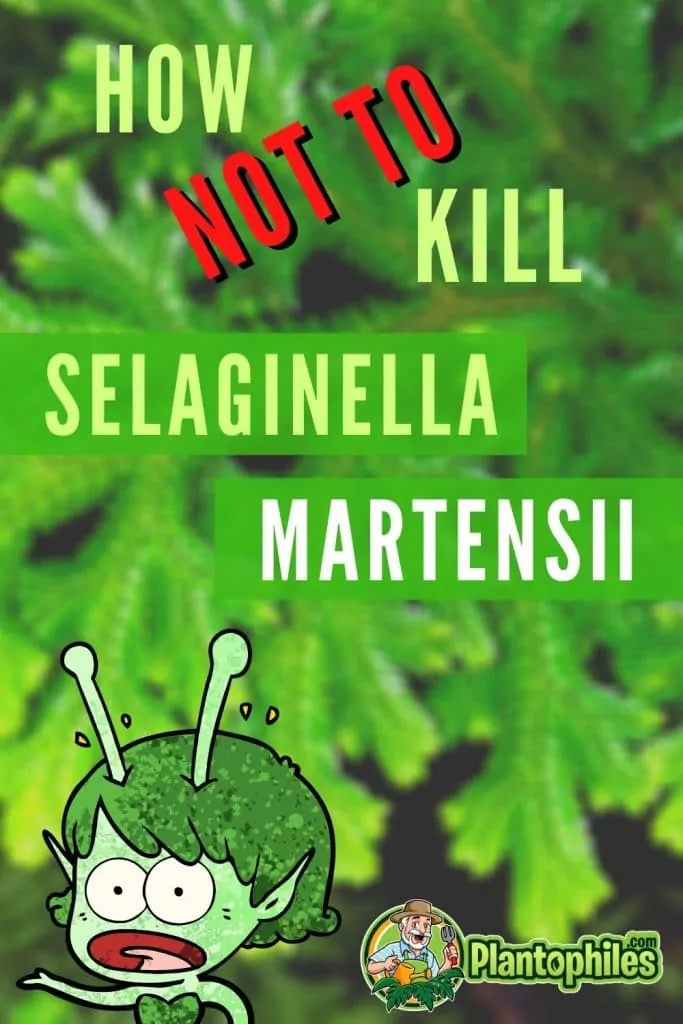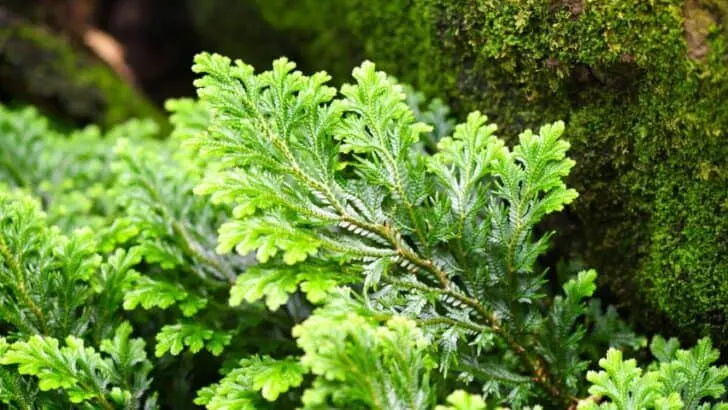Selaginella martensii, also known as Spike Moss, is one of the few plants in the Selaginella genus that make for a good houseplant.
One thing that needs to be said upfront, though, is that Selaginella martensii care is pretty difficult, as this plant has very specific needs that must be met.
Continue reading to learn how to give your Spike Moss the care it deserves!

Table of Contents
Selaginella Martensii Care
Choose a general potting soil with a pH of 5-6 for Selaginella martensii. Place it in medium to low, indirect light. Water with soft, lime-free water and keep humidity above 60%. Aim for temperatures of 20-25°C in summer and 10-15°C in winter.
Soil
When choosing the right soil for Selaginella martensii, the task at hand is pretty easy, as this plant is not very picky in this regard. You can use a general potting soil mix.
That should do the trick. A regular potting soil mix in good quality has all the crucial properties to ensure the healthy growth of your Selaginella martensii.
Aim for a soil PH value between 5 and 6. If you are unsure about the soil pH, there are a couple of ways to find out the actual value.
The easiest way to determine that value is to check the packaging of your potting soil mix. There, you usually find an indication of the soil pH.
If you mix the soil ingredients by yourself, then that probably won’t work. In this case, you might want to get a soil pH meter to determine the pH value of the soil.
These meters generally offer a lot of value for the money as they often feature 3-in-1 functionality and like this, besides soil pH, you can also easily determine soil moisture and adjust sunlight intensity.
Light
The amount of light that your plant gets is often crucial. If it does not get enough light, it may not survive. If it gets too much light, your plant might die as well.
Luckily, Selaginella martensii is rather forgiving in this aspect.
But tell me then, how much light is ideal for my leafy friend?
Regarding Martens’s spike moss, it is best to keep it in a semi-shady location.
Therefore, medium light generally yields the best results. But Selaginella martensii can also survive in low light.
But what is medium light?
On most houseplant websites, you will only hear low light, medium light, and maybe occasionally high light. And if you are an experienced plant parent, that info might be sufficient.
However, if you are a beginner, you deserve to know what is meant exactly by medium light.
What is meant by medium light is usually bright, indirect sunlight, typically with western or eastern exposure.
As we also mentioned, low light might be sufficient to keep this evergreen plant alive; here is what low light stands for:
Low light for your houseplant means that it does not get any direct light. Typically, that means that the location of your plant will be a few feet away from the light source.
There are only a couple of houseplants that can actually survive in low light, such as the ZZ plant, the Snake plant and Cast iron plants. Plants that do well in low light are usually dark green.
Watering
Selaginella martensii is one of these plants that likes to be watered thoroughly.
Use soft water when watering these plants whenever possible. Rainwater and distilled water are both fine.
If the leaves of your Selaginella martensii are very droopy, it could very well be that your plant is in desperate need of water.
When watering, also ensure you provide your spike moss with lime-free water. Just like azaleas, gardenias & orchids, Selaginella plants generally do not like limy water.
Temperature
Selaginella martensii likes warm temperatures in summer (20 to 25°C degrees / 68 to 77°F).
In winter, the temperature should be between 10 and 15 degrees ( 50 to 59°F).
You can keep them at normal room temperatures and colder temperatures. However, the ideal temperature for Selaginella is around 13 to 18 degrees (55 to 64 °F).
Humidity
Selaginella martensii prefers high humidity. This is one of the reasons why this plant is perfect to be kept in a vivarium.
Also, you could keep this leafy friend in a bottle garden or some other sort of glass container to ensure the humidity needs of your spike moss are met.
Another hack to increase the humidity for your green companion includes, as always, putting the plant container atop a trey with damp pebbles.
At this point, please note that a pebble trey only makes sense if you use a container with drainage holes!
Also, regularly misting your plant will favor a humid environment for your miniature evergreen plant.
It is fair to say that high humidity is probably the key factor in keeping your leafy friend healthy and classy.
The relative humidity for Selaginella martensii should not be lower than 60 percent. Around 80 or even a little higher is best.
As for the location of your Martens’s spike moss, the bathroom is probably your best bet, as it is usually the room that provides your plants with the highest humidity (but even there, you will need to further increase the humidity with either a trey with damp pebbles, regular misting, etc.!).
This is why plants such as Aloe Vera, Bamboo, Cast-Iron plant, Chinese Evergreen, Crotons, Dumb Canes & and other plants that demand high humidity generally do well in a bathroom environment.
If you are interested in reading more about plants that are suitable for your bathroom, please have a look at our article: The 12 Best Houseplants for your Bathroom
Fertilizer
During the growing season, feed this lycophyte every other week.
As far as feeding your houseplants go, it is better to err on the side of caution, which, in this context, means that less is often more.
Over-fertilization can be deadly for your plant while feeding too little is usually not a big issue.
Propagation
Martens’s spike moss can be propagated by cuttings.
Propagation through division is also possible.
For both methods of propagation, i.e., by cuttings or by division, spring is the most suitable time.
Growth
Selaginella martensii has compact growth and usually reaches a height of 20 – 30 cm and gets just as wide.
Pruning
Pruning Selaginella martensii is often not even necessary, as this lycophyte does neither grow tall or wide. Pruning is, therefore, only necessary for design reasons or to remove dead leaves.
(Re)potting
The general rule of thumb for Selaginella is actually to repot once it outgrows its container.
Propagating Selaginella Martensii
Selaginella martensii can be propagated through cuttings.
Selaginella can also be propagated through division.
For both methods of propagation, i.e., by cuttings or by division, spring is the most suitable time to create Selaginella babies.
Common Problems with Selaginella Martensii
Overall, the Selaginella martensii is easy to keep healthy. This does not mean, however, that they are invincible. These Aizoaceae members can fall victim to several diseases and other problems with the wrong conditions. Here are the most common:
Droopy Leaves
Cause: Possibly underwatering.
Remedy: Root rot is a serious problem for Selaginella martensii. They can’t sit in water for too long, or else the whole plant will take damage. To solve this problem, one would need to carefully remove the plant from the soil and let the roots dry out. After a few days, the Selaginella martensii can be repotted with a less aggressive watering schedule implemented.
Plant Pests & Diseases
Plant pests & diseases are luckily not a big issue for Selaginella martensii.
Generally speaking, this spike moss is not prone to disease.
Insect pests are also very rare with Selaginella martensii.
When kept in a greenhouse, slug damage is a common problem with this plant.
6 Tips to keep your Selaginella martensii problem-free
Selaginella martensii is not exactly a low-maintenance plant. For the well-being of your martens’s spike moss, you will want to follow these six tips.
- Keep your Selaginella martensii in a semi-shady spot
- Selaginella makes for a great Vivarium plant. If you do have one, put it in there!
- High humidity is key for the well-being of your Selaginella
- Don’t let the temperature get below 16 degrees
- Don’t use limy water to water your leafy friend
- If you do keep this plant outside, make sure to take it inside before the first frost
Frequently asked questions about Selaginella martensii
What are some other Selaginella species that are suitable as indoor plants?
Only a couple of Selaginella are currently cultivated as indoor plants. One of these is Selaginella apoda. Selaginella martensii care is pretty similar to Selaginella apoda care; however, not identical. Another species of Selaginella that is found in people’s homes is Selaginella kraussiana. Yet another Selaginella that is popular with houseplant enthusiasts is Selaginella lepidophylla (also known as Resurrection plant).
What are some other names for Selaginella martensii?
Selaginella martensii is also known as Martens’s spike moss and creeping moss.
Can I grow Selaginella martensii in terrarium (vivarium)?
Growing Selaginella martensii in a terrarium rather than on your window sill or any other place in your home is actually recommended. To keep your Selaginella martensii happy is much easier when grown in a terrarium, as it is easier to meet the specific requirements, such as high humidity and constant temperature, that these plants have.
How many Selaginella species are there?
The Selaginella family includes about 800 different species. However, only a few are cultivated as indoor plants.
What’s a good location for my Selaginella martensii?
Selaginella martensii likes it humid and warm. So, if kept indoors, the bathroom could be the perfect location for this miniature evergreen plant.
Where can I find Selaginella martensii online?
Selaginella martensii is less popular than other Selaginella species such as Selaginella uncinata (Rainbow moss), Selaginella lepidophylla and Selaginella kraussiana, which can usually be found on Amazon or Etsy. In fact, Selaginella martensii can actually be pretty difficult to find (online). Etsy and Amazon does not currently sell them.
Are there variegated versions of Selaginella martensii?
Yes. There is, for instance, Selaginella martensii “Variegata”. This variegated version looks very similar in shape, however, it features silvery-white leaf tips. Then, we have Selaginella martensii “Watsoniana” that features light green leaves with silvery tips.
Any display tips for Selaginella martensii?
These mossy looking lycophytes are great for basket displays. They are also suitable for display in bottle gardens and all sorts of glass containers.
What are some interesting variations (cultivars) of Selaginella martensii?
When searching on the internet, you will most likely stumble upon Selaginella martensii “Jori” (Martens Club moss) which features interesting, yellow-green leaves and Selaginella martensii “Frosty” which comes with beautiful foliage featuring white tips if the right conditions are given.

Daniel has been a plant enthusiast for over 20 years. He owns hundreds of houseplants and prepares for the chili growing seasons yearly with great anticipation. His favorite plants are plant species in the Araceae family, such as Monstera, Philodendron, and Anthurium. He also loves gardening and is growing hot peppers, tomatoes, and many more vegetables.


